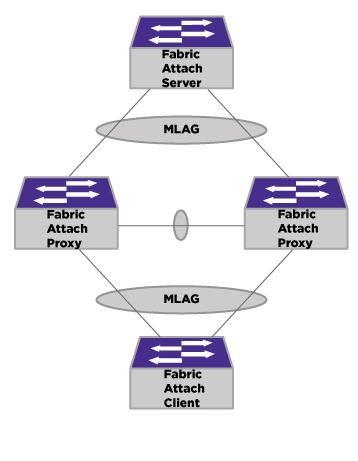Fabric Attach Support over Multi-switch Link Aggregation Groups (MLAGs)
Starting with ExtremeXOS 30.2, Fabric Attach server and proxy can work over MLAG. Starting with ExtremeXOS 30.4, Fabric Attach standalone proxy works over MLAG.

Fabric Attach Proxy Support over MLAG
When an ExtremeXOS switch acts as a Fabric Attach proxy in an MLAG configuration, the VLAN/NSI mappings are sent on the master port of MLAG by the Fabric Attach client. The same mappings are sent on the slave ports of the MLAG by the Fabric Attach client in a delayed manner. This could result in data loss if the data packets are reaching the Fabric Attach proxy attached to the slave port of the MLAG. To address this, whenever VLAN/NSI mapping information is received on an MLAG port, the Fabric Attach proxy forwards this VLAN/NSI mappings to the Fabric Attach server for authentication, and also checkpoints the information to the peer Fabric Attach proxy attached to the same MLAG. Respective VLANs received are created; ISC ports and MLAG ports are added to the respective VLAN. VLAN/NSI mappings are sent to the server for approval. After receiving VLAN/NSI mappings over the ISC link, the MLAG peer Fabric Attach proxy processes the metadata and with the received MLAG ID, it gets the local MLAG port and creates respective VLANs and ISCs. Additionally, the MLAG port is added to the respective VLANs. VLAN/NSI mappings are sent to the server for authentication. By checkpointing the NSI values across MLAG peer, redundancy is provided even if any of the client ports or server ports in MLAG go down.
For more information about MLAGs, see MLAG Overview.
Fabric Attach Server Support over MLAG
Fabric Attach server mode is also supported over MLAG, which is similar to proxy support on client-facing port side.

